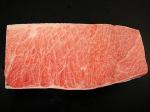Following a kind request by my good Foodbuzz friend, Elizabeth, I decided to re-post an article on this particular tuna species to clear some misunderstandings and add new information!
“Kuromaguro” or Blue Fin Tuna has become almost a mythical fish all over the world to the point that non-Japanese refer to it by its Japanese name.
“Kuromaguro”, or Blue Fin Tuna (or Tunny) has many other names in Japanese: Honmaguro, Maguto,Meji,Yokowa, Shibi, Imoshii, Shibimaguro, Kuroshibi, and Hatsu!
The best are caught in Winter mainly in the seas off Kochi (Shikoku Island), Miyagi and Hokkaido Prefectures.
This variety is the most expensive and can reach astronomical prices, especially caught in Winter off Hokkaido.
Imported Kuromaguro usually reaches Japan frozen, but in recent years the fish has been successfully raised in semi-wild environments in Spain, Australia and Croatia and arrives in Japan fresh by plane.
Imports and sales of Kuromaguro are monopolised by Japanese trade associations, unless you are lucky enough to catch one (careful here, as poaching is a major offense in Japan!).
Between you and me, if you want to eat Kuromaguro sashimi, it might come cheaper if you do it while travelling in Spain!
Did you know that Japanese importers will fly to Spain and other countries just to check that the fish are bled properly?
Now “Kindai Maguro” (近/kin for “near/nearby” and 大/dai for “big”) is the name given Kuromaguro/Blue Fin Tuna entirely human-fed (I mean fed by humans, not fed with humans!LOL).
There is big “but”, though! Huma-fed does not mean human-raised.
Young tuna have first to be located, encircled with large nets, guided near a shore and then provided with food. What people forget is that the tuna gills are hard. If the fish cannot swim freely enough it will wither and eventually die. So Kindai Tuna is nothing less than wild tuna caught into a trap and raised inside it!
BUT GOOD NEWS!
Only last week, the Tokai Marine Studies University in Shimizu Ku, Shizuoka City (Shizuoka, Banzai!) has just announced that they have succeeded in raising Kuromaguro from the eggs! What is with the recent success by fish farmers in raising another variety of Kuromaguro in Kyushu, Specialist are confident that Japan will be able to actually export completely human-raised tuna in the foreseeable future!
———————
Related terms:

Kuromaguro Otoro (fat part)

Kuromaguro Chutoro (semi-fat part)

Kuromaguro Akami (lean part)
Please check the new postings at:
sake, shochu and sushi
—————————————-
日本語のブログ
—————————————-

Kindai has had “closed circuit” pacific bluefin tuna farming since 2002.
http://www.cnn.com/2010/TECH/science/01/20/eco.bluefin.tuna/index.html
LikeLike
wow- lots of interesting info here! thanks!
LikeLike
Dear lauren!
You are most welcome!
Cheers,
Robert-Gilles
LikeLike
I have posted the blog about my dinner experience with the Kindai!
http://cookappeal.blogspot.com/
LikeLike
Dear Elizabeth!
Will check it at once!
Cheers,
Robert-Gilles
LikeLike
Thank You! Thank You! I am writing about the dinner I attended and linking this piece…I was so amazed at the pieces of Tuna, as well as the Toro. I had other species as well, but will have to refer to my notes. I will have it up by tonight. I am honored to know you my friend, you have always been one of the most informative blogs I follow. I lurk sometimes to see what is in those bento’s. Yes, the Ume-boshi was a successful attempts at fusion! Several chef friends of mine adored them as nibbles…Peace to you my friend! Chef E
LikeLike
Dear Elzabeth!
You are most welcome!
Always pleased to please!
Cheers,
Robert-Gilles
LikeLike
I love love LOVE maguro. Nice bit of information there.
One a semi-related note:
I remember watching this Japanese show on one of the channels in LA. Where two well known talents, i think it was a manzai duo, and they had to live in this one apartment and the only food was one large whole maguro. They could do what they usually do in their regular lives, but they only had to eat from that one tuna. It last for a few weeks. Then they had different challenges after that, but even though I don’t understand the language I tuned in every week just to see what different dishes were made with one huge fish.
LikeLike
LOL!
That probably put them off for a while!
Cheers,
Robert-Gilles
LikeLike
Love fresh Tuna, I imagine that eating local for you is wonderful.
I appreciate all your work on this post and the info you collected.
But I don’t think I’d buy anything that came from such a distance.
I buy local as much as possible and we have wonderful local line-caught sustainable tuna in the US.
Not as wonderful as your tuna, but we have great sushi grade tuna.
Merci…
LikeLike
Ma chere Therese-Marie!
Bomjour!
Thank you so much for your kind comments as usual!
I’m sure that you have great tuna in the States! Let’s hope we shall be able to eat some forever!
Cheers,
Robert-Gilles
LikeLike
This is a really important issue to me. I hope this means that these beauties will become prolific and sustainable. I read you regularly, but I am a bit shy about posting. this, however, was right down my alley. GREG
LikeLike
Dear Gregg!
Greetings!
Thank you for your comments!
It is also a very important issue to me to.The more because Japan is being unfairly accused of all kind of evils when it comes to fishing! This is the single country most active in marine preservation development and research!
Cheers,
Robert-Gilles
LikeLike